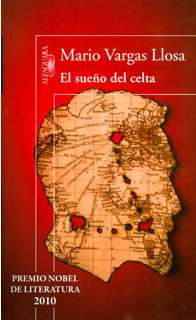The Dream of the Celt
The Dream of the Celt (Spanish: El sueño del celta) is a novel written by Peruvian writer and 2010 Nobel laureate in literature Mario Vargas Llosa.
 | |
| Author | Mario Vargas Llosa |
|---|---|
| Original title | El sueño del celta |
| Translator | untranslated |
| Country | Peru/Spain |
| Language | Spanish |
| Genre | Historical novel |
| Publisher | Alfaguara (Spanish) Faber and Faber (UK) and Farrar, Straus and Giroux (US) |
Publication date | 3 November 2010 |
Published in English | 2012 |
| Media type | Print (hardcover and paperback) |
| Pages | 464 pages |
| ISBN | 978-1616052461 (Spanish) |
The novel was presented to the public November 3, 2010 during a special ceremony held in the Casa de América museum and cultural center in Madrid, that same day it appeared in bookstores.[1] It has been a bestseller in Spain and was the most popular title at the XXIV Feria Internacional del Libro de Guadalajara.[2][3] It appeared in English in 2012.[4]
The book is a novelization of the life of Anglo-Irish diplomat-turned-Irish nationalist Roger Casement (1864-1916). The title is itself the title of a poem written by the subject.[5] The Nobel Prize committee in announcing Vargas Llosa's selection in the following fashion: "[it is] for his cartography of structures of power and his trenchant images of the individual's resistance, revolt, and defeat," seemed to simultaneously anticipate and chart the author's course in his latest work, while clearly referencing some of his most acclaimed earlier novels.[6][7]
Theme and structure
The Dream of the Celt combines elements of the historical novel with those of the journalistic chronicle; the main human and historical themes explored are those relating to the colonial subjugation and enslavement (via a process of systematic terror and torture) of the native inhabitants of the Congo Basin and the Peruvian Amazon during the latter part of the 19th and early part of the 20th century. The novel naturally and purposefully invites comparison with Joseph Conrad's Heart of Darkness (the direct appearance of Conrad in the novel leaves little doubt in this regard).[8][5]
It is within this larger context that the complex and ultimately tragic story of British consul Roger Casement unfolds. The most notable events of this vita being his exposure to and his first-hand accounts of the systematic tortures inflicted on the native inhabitants of the Congo and Peru by European commercial concerns; his attainment of a British knighthood for these same humanitarian endeavors; his subsequent transformation into a radical fighter for Irish independence, collaboration with the German military, and participation in the Easter Rising; his arrest, prosecution, and conviction for treason by the British; the late revelations of a submerged history of pederastic activities as per his own secret diaries; his execution by hanging.[9][10]
The story is told in alternating chapters, with the odd chapters detailing the last three months of Casement's life (in 1916), and the even chapters encompassing the protagonist's experiences up to that time; the latter are themselves divided into three parts, each one named after a specific colonial geography and reality to which Casement was exposed: "Congo," "Amazonia," "Ireland." Ultimately, odd and even chapters converge on a final structural and dramatic point, which is also the final point (and, in a sense, purpose) of Casement's life.
References
- Alfaguara Presentación de "El sueño del celta", la nueva novela de Mario Vargas Llosa
- "/404". www.publishersweekly.com. Retrieved 18 August 2018.
- "El Comercio "El sueño del celta" es el libro más vendido en la Feria del Libro de Guadalajara". Retrieved 18 August 2018.
- Page, Benedicte (18 October 2010). "Faber to publish new Mario Vargas Llosa novel". the Guardian. Retrieved 18 August 2018.
- Mario Vargas Llosa’s latest hero - Roger Casement
- nobelprize.org
- "The Celt's Dream released amid global expectation". Retrieved 18 August 2018.
- "The Princetonian". Retrieved 18 August 2018.
- "Home Page – The TLS". TheTLS. Retrieved 18 August 2018.
- "The Princetonian". Retrieved 18 August 2018.
External links
- Times Literary Supplement review
- The Guardian article 1
- The Guardian article 2
- Alfaguara, Spanish publisher